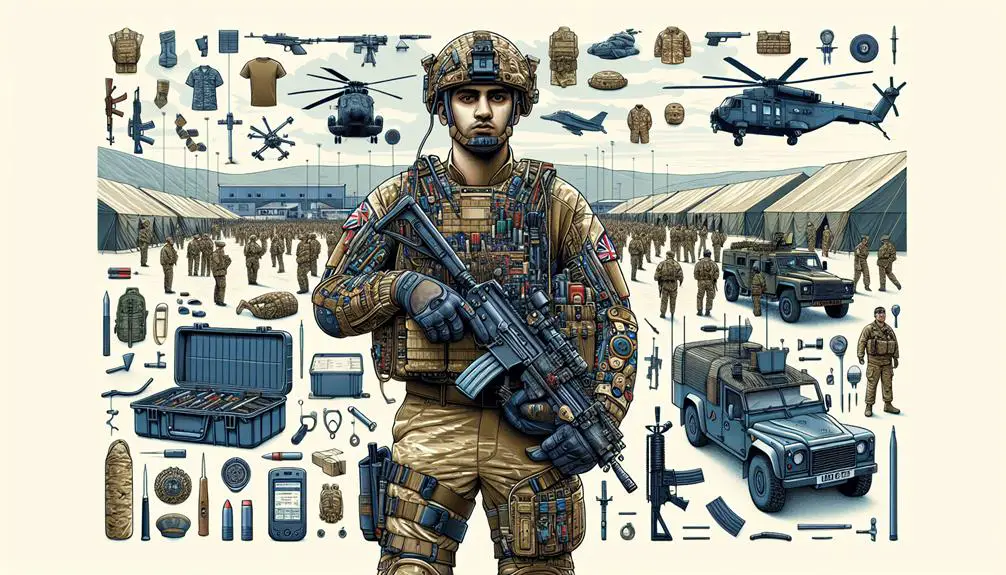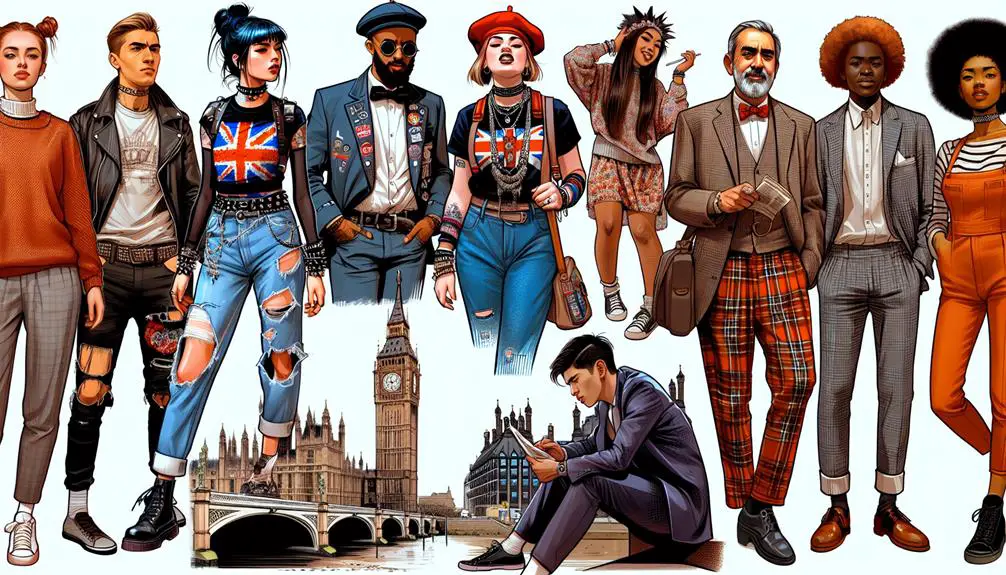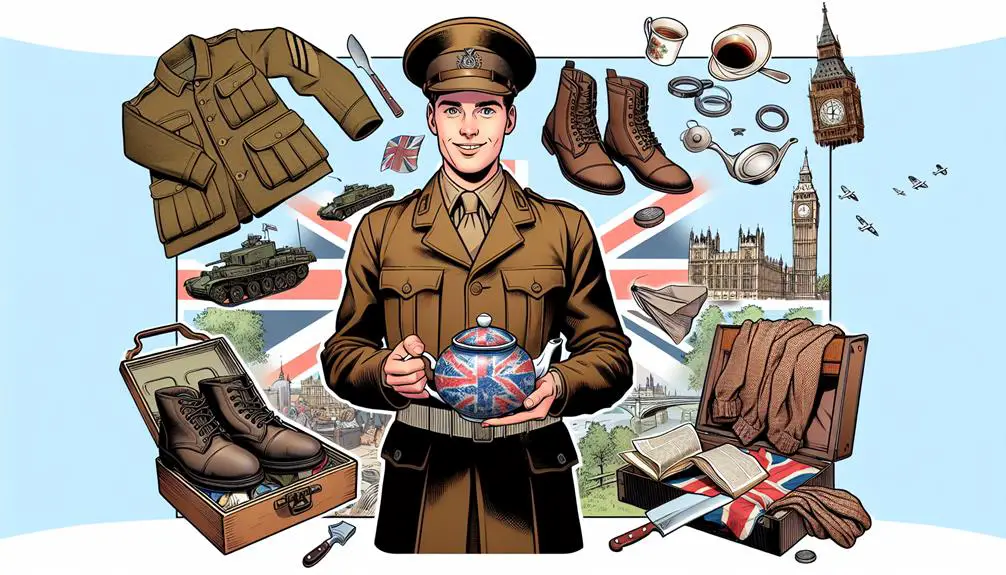Isn't it curious how you've stumbled upon this topic just as the word 'kit' is weaving its way through various global conversations? You're about to uncover the layers behind this seemingly simple term.
From its origins to its pervasive presence in sports culture, military jargon, everyday vernacular, and even the fashion industry, 'kit' holds more significance than you might initially think. As we explore its multifaceted roles, you'll discover how this term not only reflects identity but also shapes our understanding of community and belonging across different spheres.
Stick around to uncover the surprising versatility of 'kit.'
Origins of 'Kit

The term 'kit,' often used to refer to a set of personal equipment or clothing, traces its origins to the 18th century, embodying a fascinating journey through military and civilian usage that underscores its adaptability and enduring presence in British slang.
Initially, you'll find that 'kit' was predominantly a military term, denoting the equipment and attire issued to soldiers. This etymological root reflects the necessity of standardized gear for military efficiency and unity, a concept that has persisted into modern times. The term's migration into civilian parlance was, therefore, a natural progression, given the close ties between military innovations and civilian life.
Analyzing the term's etymology, 'kit' is believed to have derived from the Dutch word 'kitte,' a wooden vessel or tub used by sailors to store their belongings. This maritime origin is pivotal, as it illustrates the term's initial association with compact, essential items for travel or work, a meaning that has broadened but fundamentally remained unchanged.
As you delve deeper, you'll discover that 'kit's' expansion into broader civilian usage during the 19th and 20th centuries coincided with industrialization and the democratization of travel. The term began to encompass not only the personal belongings of soldiers and sailors but also the specialized equipment used by professionals and hobbyists alike. This transition signifies the term's versatility and its ability to capture the evolving nature of personal and professional equipment in a rapidly changing society.
Thus, 'kit's' journey from a specific military term to a widespread descriptor in British slang encapsulates a rich history of linguistic evolution, reflecting broader societal shifts and the enduring human need for terms that succinctly capture the essence of our tools and attire.
Kit' in Sports Culture
Exploring further, you'll notice that 'kit' has also carved a significant niche within sports culture, where it denotes not just the equipment but the very identity of teams and individual athletes. The term transcends its basic definition, embodying the spirit, tradition, and brand of sports entities. This evolution in meaning reflects broader cultural and social dynamics within sports communities.
- Symbolism and Identity: The 'kit' often acts as a symbol of unity and identity for teams. It's not merely about colors or designs but about representing a collective ethos and heritage. For instance, national football teams' kits can evoke strong patriotic sentiments among fans and players alike, linking individuals to a shared national story.
- Commercialization and Branding: The sports 'kit' has become a significant commercial asset. Teams and sponsors meticulously design kits, understanding that they aren't just sportswear but a crucial part of the sports brand. This commercial aspect has led to a vibrant market for replica kits among fans, turning them into walking billboards for the team and its sponsors.
- Technological Advancements: Modern sports kits are a result of sophisticated engineering and design, incorporating materials and technologies aimed at enhancing performance. Features like moisture-wicking fabrics, aerodynamic design, and thermal regulation are common, underscoring the kit's role in optimizing athletes' output.
- Cultural Significance: Beyond its functional and commercial roles, the 'kit' embodies cultural narratives. It can signal societal changes, celebrate historical milestones, or pay homage to influential figures in sports. Each iteration of a team's kit can thus be seen as a chapter in an ongoing cultural saga.
In sports culture, the 'kit' is far more than just attire or equipment; it's a multifaceted symbol of identity, commercial interest, technological progress, and cultural significance.
Military Uses of 'Kit

In military contexts, 'kit' encompasses essential equipment and attire, serving as a cornerstone of operational readiness and soldier identity. This term, deeply ingrained in military vernacular, refers not merely to personal gear but embodies a broader spectrum of tools, weaponry, and uniform components integral to a soldier's performance in the field. Analyzing the composition and function of a military kit reveals its pivotal role in ensuring personnel are prepared for the diverse challenges encountered during service.
You'll find that the military kit extends beyond basic apparel, including specialized protective gear, communication devices, and survival tools. This assortment is meticulously curated to address the multifaceted demands of military operations, ranging from combat to reconnaissance missions. The selection process for items included in a kit is underpinned by rigorous evaluation of their utility, durability, and adaptability to various environmental conditions.
Moreover, the kit's configuration isn't static; it evolves in response to technological advancements and strategic insights. This dynamic aspect underscores the military's commitment to optimizing operational efficiency and safeguarding personnel. Additionally, the customization of kits to cater to specific roles within the military hierarchy exemplifies the nuanced understanding of task-specific requirements.
The significance of the military kit transcends its practical applications, also embodying a symbol of unity and identity among service members. It fosters a sense of belonging and collective responsibility, reinforcing the ethos of camaraderie. In essence, the military kit is a multifunctional ensemble, meticulously designed to equip soldiers with the tools necessary for success while nurturing a shared sense of purpose and identity.
Everyday Uses and Variations
Shifting focus from military operations, everyday life presents a myriad of scenarios where variations of the term 'kit' apply, reflecting both necessity and personal choice in the assembly and use of such collections. In this context, 'kit' transcends its military origins, embedding itself into the fabric of daily vernacular with notable flexibility and specificity. This linguistic evolution highlights the term's adaptability to various contexts, driven by the practicalities of everyday tasks and hobbies.
- School Kit: Comprising textbooks, stationery, and sometimes specialized equipment for subjects like art or physical education, a school kit is essential for academic success. This variation underscores the necessity of preparedness in educational settings, where the right tools can enhance learning experiences.
- First Aid Kit: A collection of supplies and equipment used for giving medical treatment. Unlike other kits, the contents of a first aid kit are highly standardized, reflecting the universal need for immediate and effective responses to injuries. This use emphasizes the kit's role in health and safety protocols.
- Travel Kit: Often personalized, travel kits include items necessary for comfort and convenience while on the move, such as toiletries, adapters, and travel documents. This variation showcases the kit's role in facilitating mobility and adaptation to new environments.
- Gardening Kit: Encompassing tools like spades, gloves, and pruning shears, a gardening kit equips individuals with the means to cultivate and maintain their outdoor spaces. This example illustrates how kits can serve as extensions of personal hobbies, enabling engagement and proficiency in chosen pursuits.
Analyzing these variations, it's clear that the term 'kit' serves as a linguistic vessel for conveying preparedness, efficiency, and personalization in diverse aspects of life.
Kit' in Fashion and Identity

Delving into the realm of fashion reveals how one's kit becomes a powerful expression of identity, transcending mere functionality to embody personal style and societal trends. The term 'kit', while colloquially grounded in British slang, has evolved to signify more than just a set of clothing; it represents the curated ensemble that communicates an individual's self-concept, cultural affiliations, and even their socio-economic status to the observing world. This evolution of meaning underscores the intricate relationship between fashion, language, and identity.
Your choice of kit isn't merely about selecting pieces of clothing but about crafting a narrative of who you're and what you stand for. It's a visual dialect spoken through fabrics, colors, and silhouettes, each element meticulously chosen to align with personal and societal narratives. The transformation of the term from its utilitarian origins to a marker of identity and self-expression highlights the dynamic nature of language and fashion as tools for personal and cultural storytelling.
Moreover, the concept of a 'kit' in fashion delves into the performative aspects of dressing. It suggests that what one wears can be akin to donning a costume for the day-to-day stage of life, where personal identity and societal expectations intersect and sometimes clash. This performative aspect underlines the idea that fashion isn't passive but an active, deliberate process of engagement with the self and society.
In essence, your kit is a complex amalgamation of personal choice, cultural influences, and societal expectations. It serves as a tangible manifestation of identity, reflecting and shaping who you're in the eyes of both yourself and others.
Global Understanding of 'Kit
As the term 'kit' crosses borders, its interpretation and significance vary significantly, reflecting diverse cultural landscapes and fashion sensibilities. You'll find that, globally, 'kit' doesn't just pertain to clothing or equipment for specific activities; it embodies a broader spectrum of meanings, intricately woven into the social fabric of each region. Here's a breakdown:
- Cultural Connotation: In some cultures, 'kit' transcends its basic definition, becoming a symbol of belonging or identity. For example, in British culture, a 'kit' often refers to a sports uniform, embedding a sense of team loyalty and camaraderie.
- Fashion Influence: The fashion industry globally has adopted 'kit' to denote a curated set of apparel or accessories. This use highlights how global fashion trends influence the evolution of language, reflecting a blend of practicality and aesthetic expression.
- Military Usage: 'Kit' holds a significant place in military vernacular worldwide, denoting the equipment and attire essential for service personnel. This usage underscores the term's versatility and its ability to convey a sense of preparedness and functionality.
- Digital Expansion: With the digital age, 'kit' has found new life in tech circles, often referring to bundles of software or hardware tools. This adaptation showcases the term's flexibility, evolving to meet contemporary needs and technologies.
Analyzing the global understanding of 'kit' reveals a complex interplay between language, culture, and societal shifts. Its multifaceted nature underscores the dynamic evolution of slang, adapting to reflect new realities and collective experiences across various spheres.
Frequently Asked Questions
How Has the Usage of 'Kit' in British Slang Influenced the Development of Online Gaming Communities and Their Lingo?
You've noticed that gaming communities often adopt unique lingo, including 'kit' from British slang. This term's integration has enriched online dialogues, fostering a shared culture and enhancing camaraderie among players across various games.
In What Ways Has the Term 'Kit' Been Adopted or Adapted by Different English-Speaking Countries Outside the UK, Specifically in Informal Settings or Underground Cultures?
You'll find 'kit' has morphed in various English-speaking regions, embedding itself in informal and subcultural vernacular. Its adaptation reflects local nuances, often signifying equipment or attire specific to those underground or informal communities.
Can the Use of 'Kit' in British Slang Be Traced to Any Specific Literary Works or Publications That Significantly Popularized Its Usage Among the Younger Generations?
You're diving into a linguistic treasure trove, seeking the roots of "kit" in youthful parlance. While specific texts elude pinpointing, the term's ubiquity in media and literature has undeniably woven it into contemporary vernacular.
How Do Linguistic Experts View the Evolution of the Word 'Kit' in Relation to the Dynamics of Language Change and Youth Culture in the Digital Age?
Linguistic experts see the evolution of 'kit' as a reflection of broader language changes and youth culture shifts in the digital age, highlighting how new technologies and social media platforms drive linguistic innovation and adoption.
Are There Any Notable Controversies or Misunderstandings That Have Arisen Due to the Cross-Cultural Use of 'Kit' in Global Marketing or Branding Strategies?
You're wondering if "kit" has stirred any debates or confusions in global advertising due to cultural differences. Yes, it's led to some misunderstandings, especially when brands fail to consider its varied meanings across cultures.
Conclusion
In sum, 'kit' has traversed a vast linguistic landscape, evolving from its origins to embody roles in sports, military, daily vernacular, fashion, and identity. Like a chameleon changing its colors, 'kit' adapts to its environment, reflecting the cultural and societal shifts of its users.
This linguistic journey showcases the dynamic nature of language, where words aren't just vessels of communication but mirrors of the human experience, constantly reshaped by the hands of time and society.







